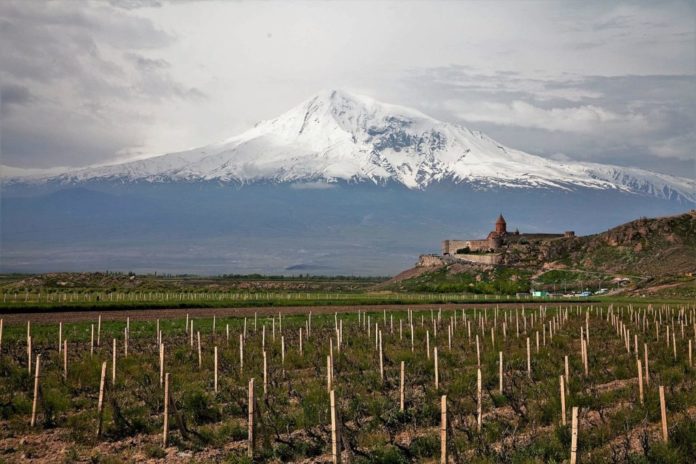
Discovering the Wines of Armenia
by Muriel Mirak-Weissbach
NOVEMBER 27, 2020 – It was Winston Churchill who made Armenian brandy famous. When Stalin introduced him to it at Yalta, he was immediately hooked. One story has it that, when asked to explain how he had managed to stay so healthy at an advanced age, he answered: “Three things: never be late for dinner, smoke Havana cigars and drink Armenian cognac.” (Another version has it, he answered: “Cuban cigars, Armenian brandy and no sport.“)
No one who has tasted Ararat brandy could disagree.
But Armenia has not only brandy to tempt the palate. Together with its legendary cuisine, it also has a wide range of wines, product of a long history of winemaking. Recently two Germans have launched an initiative to publicize this little known fact. Michael Richter comes from Bernkastel on the Mosel, famous for its own wines. With a long family tradition behind him, the connoisseur has joined with Berlin journalist Rainer Schubert to launch a website, www.weinreisen.de which is carefully researched and documented. It is part of a wine project called www.wein-inside.de Their aim is to spread the good news about Armenia’s wines, in hopes of encouraging tourism and promoting investment in the sector.
Armenia’s vineyards go back as far as 6,000 years ago, according to archaeological discoveries made in 2010. Since Armenia was part of the Soviet Union for 70 years, its wines were produced and consumed mainly there. But today about 16,000 hectares are cultivated with native types of grapes.
Rima Abrahamyan from the Vine and Wine Foundation of Armenia compiled an overview of Armenia’s wine landscape for www.weinreisen.de, divided into five wine regions. At an altitude of 1000 to 1800 meters above sea level, vineyards planted with indigenous grapes are cultivated, and thrive thanks to the varied conditions, 306 days of sunshine per year and a volcanic soil, rich in basalt, tuff and obsidian.
Aragatsotn is a wine region reaching back to the time of Noah. About 1000-1400 meters above sea level, the region lies near Yerevan, with Ararat visible in the distance. This is the birthplace of the old Armenian grape type Voskehat, known as the “queen” of Armenian grapes, and was first cultivated 3500 years ago. Among the wine-growing estates here are the Armenian Wine Company, Golden Grape ArmAs, Van Ardi, Voskevaz Winery, Mnatsakanyan Gastro Yard, Tsaghkents Maran Gastro Yard and Yeganyans’ Guest House and Wine Yard. Many of these winegrowers are family enterprises with a long tradition; others are younger and have benefited from cooperation with the United Nations Development Programme and high tech input from Italy.
Water has been transformed into wine since 4100 B.C. in the wine region Vayots Dzor. Two hours outside the capital, it is at the heat of the historic wine world and is a must for any wine enthusiast. Located in the village of Areni, on the banks of the Arpa river, is the Areni-1-cave, known as the bird cave, which provides proof of biblical and historical accounts that the Armenian mountain areas were the birthplace of wine. In 2010, archaeologists unearthed a wine cellar that is the oldest example of deliberate wine production. The earthenware vessels and casks provide proof of well planned pressing and distilling of grapes in the copper age, that is, 6000 years ago.
In this region, also, many of the wine growers are family enterprises, like the Old Bridge Winery, Bed & Breakfast and the Matevosyan Wine Company. Other wine growers include the Trinity Canyon Vineyards, Vayq-Group — built on lava — the Aghavnadzor Gastro Yard (assisted by UNDP), and other Gastro Yards: the Arman Hakhverdyan, Ghazaryans’, Matevossyans’ and Noravank B&B.
Armavir is another region whose wine production reaches back to 4100 B.C. Considered the spiritual center of the first Christian nation, it is intimately bound to the country’s identity. The Blessing of Grape is a religious holiday here, celebrated on the second Sunday of August, when the entire grape harvest is blessed. Among the wine growers in Armavir are Alluria Wines, Apartney Wine, Karas Wines, and Maran Winery. Maran is a very old establishment, founded by Sargis and his wife Maran when they returned from Persia in 1828-1830. Among the wines it produces are “Noravank,” “Bagratuni” and “Malahi.” Voskeni Wines is a family venture in Sardarapat, founded by an Armenian American in the 1920s, whose enterprise was seized by the Bolsheviks and later restored by family members. Kalashyan’s Gastro Yard produces not only wine but also fruit vodka.
Tavush, famous for its monastery and breathtaking landscape, has been a wine-producing region since the middle of the 5th millennium B.C., as documented by grape seeds found in the neolithic Getahovit-2-Cave. Here Bekri Gastro Yard and Davtyans’ Gastro Yard offer their produce, together with musical events.
Ararat is the last region presented, Armenia’s second largest wine region, with 300 days of sunshine. Here the Tushpa Wine Cellar offers wines and interactive wine tours. “The next time you think about where you want to travel,” Rima Abrahamyan suggests, “whenever in the current situation we are able to do so, come to Armenia, to discover the history of mankind and wine growing with every bottle of Armenian wine.”